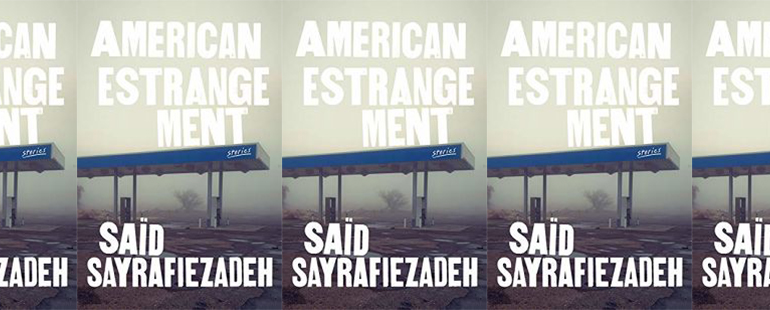The Illusion of Progress in American Estrangement by Saïd Sayrafiezadeh

American Estrangement
Saïd Sayrafiezadeh
Norton | August 10th, 2021
Saïd Sayrafiezadeh’s short story collection American Estrangement reveals a middle-class sloshed in mediocrity and monotony, unable to progress beyond a goal line that seems perpetually moved out of reach. An aspiring actor trudges through a construction job, dreaming of Hollywood fame. A son visits his dying mother in a gentrifying neighborhood that holds onto a Goodwill for when the houses devalue again. A young couple drives cross country and is stopped by border checks at each state line. Running through all the characters’ minds is the question of what if: what if they were more successful, more in love, freer?
Sayrafiezadeh’s stories offer a reality uncanny to ours today, like the TV show Black Mirror, but not with scenarios decades from technological reach. Instead, Sayrafiezadeh’s reality quivers seemingly months away from our own. It hinges on the recent White House administrations, which looms eerily in the background of each story’s narrative. Sayrafiezadeh shows how little the dial needs to be turned for American society to reach this strange state of “freedom,” one in which everyone must carry out a role, lest the lower and upper classes become too crowded. And Sayrafiezadeh crafts this world with subtle hands, employing a first-person perspective throughout to give characters a sense of isolation. They seem different and desperate, like they can almost get out but fail to liberate themselves from an ever-narrowing presence of social and governmental systems that permeate their everyday.
For example, in the first story, “Audition,” a college dropout works for his father’s construction company and talks up his Hollywood dream to one of his colleagues. The protagonist is close, he explains. He just needs to pack up and go, then he’ll get his shot—an agent and his first booked gig. When he gets a call from his high school drama teacher to audition for a local play, the protagonist’s emboldened by the flattery. But when the protagonist enters the gym, a wink at the amateurish setup, he notes, in shock, the number of other actors going out for the same role: “We were perfect replicas of one another, dressed in khakis, hair blow-dried, walking around doing the same vocal warm-ups that we had been taught.”
While some in Sayrafiezadeh’s collection dream of escaping their reality, others savor the monotony of the everyday, aspire to maximize the predictability of mediocrity. In “A, S, D, F,” an allusion to the sequence of letters on a keyboard, the protagonist works the front desk at an Aspen gallery that sells expressionist art. He sits “engulfed in a sea of silence.” Sometimes, the owner has him type, not on the gallery’s computer but a typewriter, letters of inquiry to sell a painting that won’t sell. While he silently complains, the protagonist revels in the hour-long lunch breaks he gets—predictable, like clockwork, like the letters he strikes against the page within the margin his boss sets for him.
And it is during his lunch break that Sayrafiezadeh inserts a thematic anchor in the collection. Curious, the protagonist watches the bystanders watching a commercial film on the street, trying to catch a glimpse of Olympic medalist and celebrity snowboarder Shaun White. He pities them and the production assistant, who remains “one hundred degrees of separation removed” from the center of power. A child on a parent’s shoulders claims to see the young celebrity cutting down the snow, a fact the protagonist dismisses and moves on. This protagonist positions us, the reader, in his point of view during this sequence and asks, What’s the point if you’ll never reach the top of the mountain? Why expend energy on something that was built to remain unattainable? This protagonist, unlike most of the others in the collection, is aware of the machinations that entrench corporate and middle America. He acknowledges the futile by denying it, occupying a space between nihilism and utopia.
In other stories, as in “Scenic Route,” Sayrafiezadeh explores an American future constrained by government oversight. A couple drives cross-country, showing travel papers like grade school hall passes, worried someone will find them insufficient or expired as they answer ever-more piercing questions from government officials. While they live beyond their means in this cryptic near-future America—we’re given few details, left to fill in gaps of a political environment that demands proper documentation to prove not just identity but approval to traverse land—it’s the love story at the center that raises the stakes.
We learn, through a series of flashbacks, how the couple met online. They lie about how tall, fit, and interesting they are. Their dating avatars are like the papers they show along their road trip, a role they must play to pass for something other than themselves. These aren’t social smokescreens relegated to fashion, career, or location of neighborhood but a fully documented system that entraps citizens, sometimes willingly sometimes unwillingly, from bedroom to municipality. In the story, border checks extend beyond brown and Black Americans—it’s Sayrafiezadeh’s warning shot that they happen to anyone.
The estrangement in America that Sayrafiezadeh describes is one near to our current reality. The isolation his characters try escaping or accept within burgeoning socio-political structures feels just around the corner, a stutter step we’re taking before the next volley of the American experience hits while we dredge on, most of us unaware of the increasing degrees from the center of power. The collection uncovers the illusion of progress in America, like the celebrity we never quite see make it down the mountain but swear we do.


